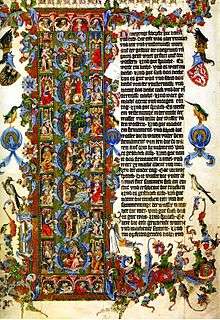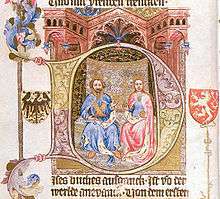Wenceslas Bible
The Wenceslas Bible[1] (German: Wenzelsbibel) or the Bible of Wenceslaus IV (Czech: Bible Václava IV.) is a multi-volume illuminated biblical manuscript written in the German language. The manuscript was commissioned by the King Wenceslaus IV of Bohemia (that time also the King of the Romans) and made in Prague in the 1390s. The Wenceslas Bible is unique and very precious not only because of its text, which is one of the earliest German translations of the Bible, but also because of its splendid illuminations. This oldest German deluxe Bible manuscript[2] remained uncompleted.[1]
| Wenceslas Bible | |
|---|---|
| Vienna, Austrian National Library (Cod. 2759–64) | |
 Initial of the book of Genesis – 7 days of creation. | |
| Type | Bible |
| Date | 1390s |
| Place of origin | Prague |
| Language(s) | German |
| Illuminated by | Frána Kuthner and others |
| Patron | Wenceslaus, King of the Romans and King of Bohemia |
| Material | Parchment |
| Size | 1,214 leaves |
| Format | 530 x 365 mm |
| Contents | Old Testament (Daniel, Minor Prophets and Maccabees missing) |
| Illumination(s) | 654 miniatures |
Historical context

The Wenceslas Bible contains the text of one of the earliest Bible translations into German. The translation from the Latin Vulgata was commissioned by the wealthy burgher of Prague Martin Rotlev about 1375–1380.[1]
Although Wenceslas' father Emperor Charles IV forbade Bible translations from Latin into vernacular languages as heresy in 1369, king Wenceslas with his second wife Sophia disrespected his father's order by their patronage of this spectacular edition of the new German Bible translation. Their own patronage confirms an inscription in the manuscript. It indicates the close relationship between the Bohemian royal court and the nascent Bohemian Reformation.[3]
The Wenceslas Bible was never completed. The Book of Daniel, the Minor Prophets and the Books of Maccabees are lacking from the Old Testament and the New Testament was not even begun. The Bible contains 654 miniatures and initials; some were only scratched. The scribe left free spaces for more than 900 other illustrations. If the Bible were completed, it would have comprised about 1,800 leaves with circa 2,000 illuminations and would accordingly have surpassed all other medieval manuscripts in length, dimensions and wealth of artistic ornament.[1]
Gallery
 Kingfisher – the personal emblem of Wenceslas IV
Kingfisher – the personal emblem of Wenceslas IV Construction of the Tower of Babel
Construction of the Tower of Babel Creation of Eve
Creation of Eve Female bath attendants washing King Wenceslas
Female bath attendants washing King Wenceslas
References
- Boehm, Barbara Drake; Fajt, Jiří (editors) (2005). Prague: The Crown of Bohemia, 1347–1437. New York: Metropolitan Museum of Art. pp. 220–222. ISBN 9780300111385.CS1 maint: extra text: authors list (link)
- "The Wenceslas Bible – Complete Edition". www.adeva.com. Akademische Druck- u. Verlagsanstalt Graz. Retrieved 12 June 2014.
- Boehm, Barbara Drake; Fajt, Jiří (editors) (2005). Prague: The Crown of Bohemia, 1347–1437. New York: Metropolitan Museum of Art. p. 99. ISBN 9780300111385.CS1 maint: extra text: authors list (link)
External links
| Wikimedia Commons has media related to Bible of Wenceslaus IV.. |